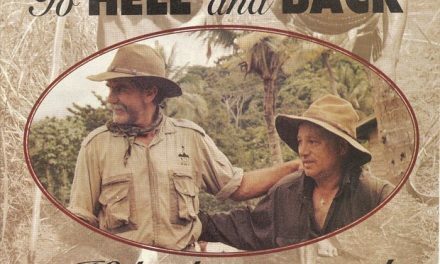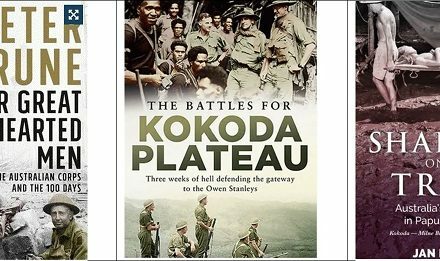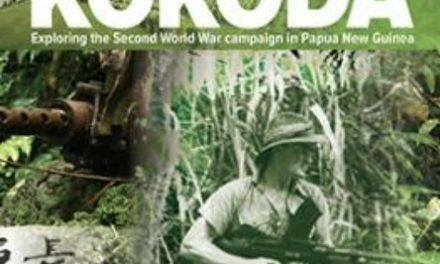Despite the deaths Australians are drawn to take the challenge, writes Erik Jensen from the Sydney Morning Herald, who has just completed the RSL Services Clubs Kokoda Youth Challenge with Adventure Kokoda.
There are not the words in Koiari to ask about Kokoda’s spirit. That is an Australian construct, and a reasonably modern one: the sort that made Paul Keating bend down and kiss the earth at Kokoda in 1992, that wrote the word ”mateship” on the memorial built there a decade later, and sends almost 6000 Australians down the track each year.
After six days on the track I sit in front of one of the last Fuzzy Wuzzy Angels, Ovuru Ndiki, and attempt to ask the question anyway; to understand why it is everyone but the Australians must be paid to walk what was, 100 years ago, a simple mail route. Why four years ago we started doing it in such numbers, at such cost, to such risk.
‘‘It’s something to remark on what happened,” Ndiki tries to explain the idea of spirituality, 105 years closing in around his eyes and emptying his mouth of teeth. ”There is some of us left behind. Walking the track, you can pick up pieces of that.”
In the past decade, the number of people picking up those pieces has increased 74 times. It is now Papua New Guinea’s most popular land-based attraction – a band of wealth in the jungle, worth as much as $50 million a year, supported entirely by Australians.
Sports teams come here to bond. Kevin Rudd and Joe Hockey made it one of the first legs of 2007’s Sunrise election. Bags at the airport must now be X-rayed for souvenired grenades. Where two years ago there were five trekking companies, now there are 30. ‘‘If you can get yourself a business card, you can take people up the track,” says John Nalder, who guides me through the 133 kilometres. ”It’s really exploded since 2005.’‘
At night, you can hear the sound of sobbing coming from tents. The track is, without question, the most difficult thing I have done. The climbs are ceaseless and painfully steep. At one point, doubled over with food poisoning that will last six days, I black out from vomiting.
‘‘Amazing” is the most common description of the trek. Then gruelling. In 10 days, I lose 13 kilograms. ”Everything is a search for something, a search for identity, for who they are,” Nalder says. ”Australians have had a cringe about who they are, and that’s changing. I do get people who want to brandish the flag, but it’s a love thing, it’s a patriotic thing. It’s not the redneck, white supremacist one.”
The track itself is almost an extension of Australia. It was, until 1975, part of an Australian territory. Even now, villagers along the track wear jerseys from the National Rugby League. There is a discarded Vegemite jar on the climb out of Isurava and dull triplets of ”Aussies” and ”Ois” ring through the Owen Stanley Ranges.
Many more Japanese soldiers died here than the 625 Australians killed. But Japanese almost never walk Kokoda. Those that come are usually flown in and out by helicopter. They are there not to experience some national myth but to farewell ancestors. Of the two Japanese memorials on the track, one has had the muzzle of its gun set into the ground – a mark of submission lobbied for by the RSL. The other has been destroyed by trekkers.
”We get so much exposure to American culture that’s so strong and so steeped in history. Perhaps we’re trying to get on to some of that,’‘ says Andrew Skehan, a 30-year-old history teacher who won a 2GB competition to walk the track. ”The new national curriculum – Australian history is the first thing on there. Perhaps Australia’s push towards a place on the international stage makes us see we have to define ourselves so we can say we stand for something.” For the most part, however, trekkers struggle to explain why they have come; what made them spend up to $6000 on a journey through heat, mud and steep climbs, with heavy packs and sickness. For those without relatives who fought in the 1942 campaign, there is vague mention of achievement. A walk that would buy them a beer back home, with something about national history on the side.
But the words of Nathaniel Ryan, a 17-year-old preparing to join either the police or the army, are more common: ”Mate, I’m just concentrating on where to put my feet.”
The place of Kokoda in Australia’s psyche is a vestige of Keating’s cosmopolitan prime ministership. This was his region. In 1995, wearing a hornbill headdress, he was inducted as an Orokaiva chief in Kokoda. But it was only after a decade of John Howard’s narrowed patriotism that Australians started walking the track in any great numbers – and the story of Australians defending Australia really set in. A book from Peter FitzSimons helped, too.
Three years before Keating’s chiefly induction, he and his entourage flew three RAAF Caribou transport planes to the Kokoda airstrip. It is a cleared piece of jungle, below the razorback country where the fighting took place, with a palm oil plantation on one side and grassland on the other.
At the expense of Gallipoli, he described this earth as the essence of Australia’s nationhood. Standing a day’s walk from that spot, on the hillside where the monument Keating wanted was finally built, two girls start crying. My trek leader cries also. A 17-year-old youth announces he will join the army.
”There can be no deeper spiritual basis for the meaning of the Australian nation than the blood that was spilled on this very knoll, this very plateau, in defence of Australia,” Keating said here the year that youth was born. ”This was the place where I believe the depth and soul of the Australian nation was confirmed … The lesson of this place is that those young men believed in Australia and we need to give Australians – all Australians, particularly young Australians – an Australia to believe in.”
By 2004, as Howard began in earnest his flag-pole assault on Australia’s ”values neutral” schools, the Kokoda walking had already begun. Records, which only start in 2001, show 76 trekkers in a year. By 2005, that number had grown to 2374 and has continued to almost double each year since.
That there are both a 96-kilometre tourist track and the 133-kilometre wartime version says a lot about what Kokoda has become. ‘‘I was moved, more so than I expected to be,” says Bec Walsh, a 21-year-old medical science student, part-way down the track. ‘‘It’s hard not to be affected.’‘ Walsh is there as part of an RSL program to educate young leaders. It is the same program that was used, more or less, for the national rehabilitation of Ali Ammar after he desecrated the Australian flag in the Cronulla Riots reprisals. ClubsNSW also fund a group.
”I don’t know if I feel more Australian,” says Clair Edwards, who was chosen to walk the track because her grandfather fought there. ”But I feel more deeply in touch with my heritage. I have this deep attachment, it’s not just knowledge; now, it’s emotional. I know my country on a more personal level.”
The people walking the track have changed in the past two or so years. There are fewer trophy trekkers, fewer people walking simply to say they did it. They are now more likely to be middle-aged than young adventurers – men with to-do lists, who carry pictures of fathers who fought on the track. But while their fathers had an average age of 18 when they fought here, these men have an average age of 50. ”My dad told the larrikin story, the fun stories,” says Martin Stuart, a 48-year-old engineer whose father was in the 39th Battalion. ‘‘But I’m here to find out the rest, to piece it together.’‘
A day earlier, a trekker in Mr Stuart’s group died after less than two hours on the track. Four others have died in the past 12 months.
They are joined by the 13 who died on a Twin Otter flying to Kokoda to begin the trek in August. The deaths are, in some ways, understandable – the trekkers are older, there are more of them, unscrupulous providers are walking without satellite phones or medical supplies – but the effects on the market are unknown. Some suggest the deaths make the myth more real, that memorials to modern dead have been seen up and down the track for years.
”It’s not helpful,” the chief executive of the Kokoda Track Authority, Rod Hillman, says. ”It’s difficult to move forward until we find the cause of death. The newspaper here is reporting [the most recent death] as an aneurysm. That could happen watching TV. But the growth’s been quite exponential. I think it’s unlikely to get that growth again.’‘
Erik Jensen trekked with the Kokoda Youth Challenge – a leadership program for young people developed by Adventure Kokoda and supported by the RSL Services Clubs Associaition and Clubs NSW. Eriks’s trek was led by John Nalder and Jo Roberts of Adventure Kokoda.





